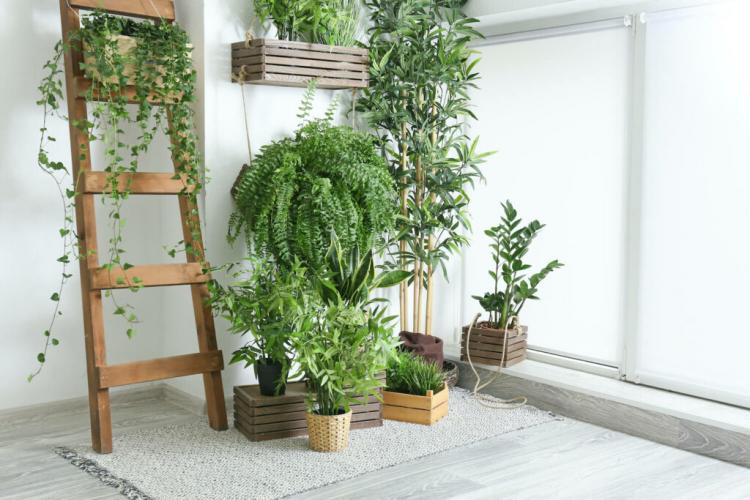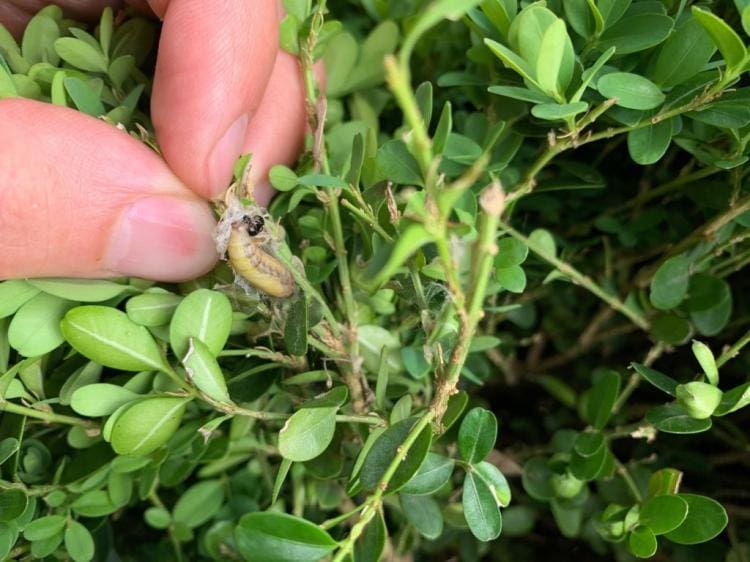Aphids on indoor plants: causes & tips for natural control
No houseplant owner likes to see the little white lice. We reveal the causes of lice on indoor plants and how the aphids can be combated naturally.

Aphids, such as mealybugs in this case, can also be found on indoor plants in the apartment [Photo: daguimagery / Shutterstock.com]
Aphids are often uninvited guests not only in the garden, but also in living rooms or in the winter garden. Aphids are not very particular about their choice of host plant, which is why exotic houseplants can also be attacked by aphids. We will show you how you can recognize an aphid infestation on indoor plants and combat it naturally.
This is how you can recognize aphids on indoor plants
Table of Contents
Lice are an ugly idea, especially in the home. But how do you recognize aphids on indoor plants? Aphids can be seen with the naked eye if you look closely. These are 1 to 6 mm large insects that can be yellowish, reddish, white-gray, black or green, depending on the species. Since they prefer to be at the shoot tips and flower buds, we recommend that you take a quick look at these areas on a regular basis. Their suction activity on the phloem of the plant often results in deformed leaves and reduced shoot growth. The tips of the shoots even hang down when the infestation is severe, as the aphids locally extract a lot of water. When sucking the sap, aphids ingest more sugar than they need. They excrete the remaining sugar as so-called honeydew. This honeydew forms a shiny and sticky layer on leaves or your windowsill. If the infestation is more severe, the leaves may turn yellow.
How can you spot aphids on indoor plants?
- Aphids on indoor plants are usually visible to the naked eye at the tips of the shoots
- 1 – 6 mm large insects, yellowish, reddish, white-gray, black or green in color
- Deformed leaves and limp shoots
- Reduced growth in severe infestation
- Shiny, sticky honeydew on and under the plant
Tip : Aphids do not only damage your plant by removing sugary plant sap, but can also transmit plant viruses, which then damage your plant additionally and which can only be combated preventively or by destroying the plant.

Aphids prefer to suckle on young, soft shoots and buds [Photo: Catherine Eckert / Shutterstock.com]
What lice are there on indoor plants?
Black, green or red aphids on house plants
For example, black lice on indoor plants can be the black bean louse ( Aphis fabae ). It is one of the most common aphid species outdoors, but it also finds its way into the living room again and again. But there are many other black lice, for example the black cherry lice (Mycus pruniavium).
White lice on house plants
Are you wondering what kind of small, white and woolly dots are on the tip of the shoot or the stem of your plant? These are not aphids, but mealybugs (Pseudococcidae). Although they are very small at around three millimeters in size, they are easily visible due to their light color. The most common representatives are the citrus louse ( Planococcus citri ) and the long-tailed louse ( Pseudococcus longispinus ). The lice get their white appearance from layers of wax on their bodies. Some of these small wax flakes fall off the animals and give an indication of a mealybug infestation. In addition, mealybugs also produce honeydew. In addition to citrus plants, mealybugs infest many different houseplants, such as rubber trees ( Ficus elastica ), elephant feet ( Beaucarnea recurvata ), or orchids (Orchidaceae). Even cacti (Cactaceae) are not safe from mealybugs. But with the right tricks, mealybugs can also be reliably identified and controlled.
Which symptoms are typical of a mealybug infestation?
- White insects a few millimeters in size
- White powder on leaves or potting soil
- Honeydew
- Reduced growth in severe infestation

Such a severe mealybug infestation on a rubber tree should be treated quickly [Photo: ViktoriaIvanets / Shutterstock.com]
The cause of aphids on indoor plants
As airborne insects, aphids can easily get into the house through an open door and reproduce en masse on a suitable plant through their first generation. Or they are introduced into the apartment through plants, either through the purchase of new plants or through house plants that were outside in summer and are brought back into the apartment in autumn. Before a plant comes into your home, you should examine it for aphids and treat them outside the home if infestation occurs. Also in the first two weeks after the newly arrived plant is in your home, you should pay close attention to a possible aphid infestation. By the way, aphids feel extremely comfortable in our dwellings and therefore spread quickly. Because aphids prefer dry and warm air, which is especially prevalent in apartments in winter. In addition, weakened plants that may suffer from nutritional deficiencies or a wrong location are more likely to be infested.
What are the causes of aphids on indoor plants?
- Access as winged insects or via new houseplants
- Dry air
- Weakened plants due to incorrect location or care

A bright location and regular moistening of your indoor plants prevent aphids [Photo: Pixel-Shot / Shutterstock.com]
Combat aphids on house plants naturally
What to do if you have discovered an aphid infestation on your indoor plants? We recommend that you refrain from using synthetic pesticides and prefer natural measures, especially in the interior, where you have a lot of contact with the plants. When you discover an infected plant, isolate the infected plant first to prevent the lice from spreading to indoor plants. Then a number of measures are available to you:
Wash off aphids
Aphids don’t like it damp and can’t hold on to your host plant well, which is why they can be washed off. For small indoor plants, submerging the entire plant in water is suitable. The pot can be wrapped tightly with a cloth to prevent the soil from being washed out. The plant should be kept underwater for two hours to loosen the aphids from the plant. This measure is not suitable for cacti, as they do not tolerate water-saturated soil. For larger plants, you can put them in the shower and rinse them off with a jet of water. You should also protect the pot here to prevent the soil from being washed out. The strength of the water jet should be chosen so that the plant is not damaged. This procedure should be repeated once a week. In addition, we recommend spraying the plant with water every day to achieve a more humid microclimate.
Neem products
A particularly effective way to control aphids on indoor plants are neem-based agents. These are obtained from the seeds of the neem tree. These seeds contain an oil that is great for controlling aphids on indoor plants. The natural active ingredient azadirachtin from neem oil is absorbed by the lice when they suckle. The aphids stop sucking after just a few hours. In addition, the active ingredient disrupts the development of the lice, causing all generations on the plant to perish. Our Plantura organic pest-free neem is also based on neem oil and enables you to biologically control aphids on indoor plants.
Plantura Bio-Pest Free Neem is simply mixed with water to form a suspension and sprayed onto the affected plant with a spray gun. Correct use of any crop protection product is very important. You will find detailed information and instructions for use on the product packaging; you can study the safety data sheet in advance in the shop.
You May Also Like Is Neem Oil Safe for Cats and Dogs?
Soft soap or nettle stock against aphids
A soft soap solution consisting of 0.2 liters of soft soap and one liter of water can be sprayed onto the infested plant with a spray bottle. The best way to do this is to put the plant in the shower or bathtub. It is best to repeat this in the morning and in the evening over several days until you can no longer see any aphids.
How to use soapy water against aphids:
- Soapy water from 200 milliliters of soft soap to one liter of water
- Spray on the infected plant twice a day
Nettle is also uncomfortable for aphids. For a nettle stock, put 500 grams of fresh nettle and five liters of boiling water in a saucepan and let it stand for 24 hours. After you have strained the brew through a sieve, you can apply the cold brew to the infested plant with a spray bottle. You can repeat this in the morning and in the evening over several days until you can no longer see any infestation.
How to use nettle stock against aphids:
- Nettle stock made from 500 grams of fresh nettle and five liters of boiling water
- Spray on the affected plant twice a day.
You can find out more practical home remedies for aphids in your garden or apartment in our article 10 Home remedies for aphids.

If the aphid infestation is still low, home remedies can be effective enough [Photo: ULD media / Shutterstock.com]
Prevent aphids on indoor plants
Good prevention is the best possible care for your indoor plants: if they are healthy, in the right place and if they are adequately supplied with water and nutrients, they are less susceptible. With an optimal supply of potassium, the plant cells become more stable and are better equipped to deal with aphids. Our Plantura organic indoor & green plant fertilizer provides optimal care for your indoor plants.
An optimal supply of nutrients and care is a challenge, especially with orchids. Therefore, orchids are often attacked by mealybugs. One of our special articles covers common mistakes in orchid care and shows you a few tricks on how to proceed.






